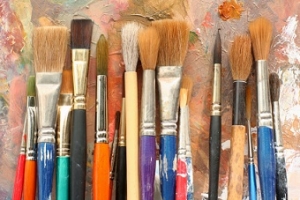What Art Therapy Approach to Use for Eating Disorder
Express Yourself: Art Therapy's Bear upon On Eating Disorder Recovery
 Eating disorders are one of the nigh complex disorders, and have the highest mortality rate of any other psychiatric illness. What is understood from eating disorders is that at that place isn't one exact reason that an eating disorder exists, but many puzzle pieces that may fall into place at 1 specific fourth dimension inside an individual'due south life, which creates the eating disorder. People don't choose to have an eating disorder. There are many biological, psychological, and sociological factors that play a role in the development of an eating disorder, and recovery from an eating disorder tin be difficult, but it is possible to achieve a full and sustained recovery. For someone who does not suffer from an eating disorder, information technology tin can be hard to fully comprehend the multitude of intrusive notwithstanding unwelcome thoughts circulating in someone'south mind related to food, body image, and feelings of shame and guilt. The affect of art therapy on eating disorder recovery has been shown to be a powerful tool.
Eating disorders are one of the nigh complex disorders, and have the highest mortality rate of any other psychiatric illness. What is understood from eating disorders is that at that place isn't one exact reason that an eating disorder exists, but many puzzle pieces that may fall into place at 1 specific fourth dimension inside an individual'due south life, which creates the eating disorder. People don't choose to have an eating disorder. There are many biological, psychological, and sociological factors that play a role in the development of an eating disorder, and recovery from an eating disorder tin be difficult, but it is possible to achieve a full and sustained recovery. For someone who does not suffer from an eating disorder, information technology tin can be hard to fully comprehend the multitude of intrusive notwithstanding unwelcome thoughts circulating in someone'south mind related to food, body image, and feelings of shame and guilt. The affect of art therapy on eating disorder recovery has been shown to be a powerful tool.
Many people ask the question, "What is art therapy?" This question, many times is followed with the statements, "I am not an artist" or "I tin can't do fine art." Art therapy is a manner of communication; it is communication through symbols, colors, textures, and even sometimes glitter. Fine art therapy establishes communication betwixt people and allows a person to detect a sense of clarity or understanding that may be difficult to practice by using words alone. Fine art therapy is able to ask questions virtually the inner experience, and help people express emotions and ideas that may be hard to project verbally. Art therapy may also let someone to sympathise a person'due south perception or behavior, permit for self-understanding, or support personal growth. Fine art therapy simply may let a identify of rubber and fourth dimension for soothing. The finished production may visually non be pleasing, although the art and process of making the art may accept been cathartic for the individual. The art may besides communicate relevant material for a therapist to piece of work with a client to support change and recovery.
At present, it's time to express yourself – into recovery. Art therapy's touch on on eating disorder recovery has been shown to support an improved agreement of cocky, and visually create something that is difficult to verbally explicate. Many times information technology is explained from someone with an eating disorder that in that location is a lot of internal conflict. How is this relayed or communicated to family unit, friends, or their peers within a grouping setting? Art therapy directives ask group members to create art effectually these internal conflicts, many times revealing to members of the group that they aren't alone. What a relief information technology appears to be every bit others can chronicle to an internal conflict that previously no 1 would exist able to communicate with words. One example of this may be an art therapy grouping using masks.
In this typically powerful grouping, group members were asked to create a mask expressing, "what do y'all share with the globe and what do you keep inside." Many members of the group were able to discuss their hidden eating disorder, the behaviors which they kept surreptitious, and the fright of recovery or relapse. Grouping members were able to discuss anxiety and fear of their perceived imperfection, if others were to come across the mask as they viewed information technology from the inside. The masks weren't perfect, they were powerful. The safe space that the art therapy group created immune the grouping members to 'have off their masks' and share experiences, goals toward increasing conversation with family members, and to increment the likelihood of using these coping skills to claiming disordered thinking, requite and seek support to and from others, and often times, allow a place for recovery to offset.
Recovery isn't perfect and fine art isn't either. Art therapy creates a span from isolation and distorted thinking patterns to a connexion with others, equally well as understanding and validation. As simple as information technology is to put paint, masks, and a few extra materials on the table, the talked about directive led a group into a word which is difficult for anyone to have. For people who suffer from eating disorders, fine art tin can offer a place of healing or only an action of distracting or self-soothing. Fine art therapy tin allow for a time of rest for a busy listen, and for a moment, information technology can help in turning the listen from a willful place to a willing and visual perspective toward what recovery may wait like – and that information technology is possible.
####
Virtually the author:
 Nicole Pipitone, MAAT, LPC is currently the pb clinician for the adolescent PHP and IOP programs at Walden Behavioral Care in Southward Windsor, CT. Nicole received her main's caste in fine art therapy and clinical counseling from Albertus Magnus College. In 2012, Nicole establish an interest in working with the eating disorder population and began working at Walden in 2013. During this time, Nicole has supported the growth of the adolescent programs for both parents and adolescents through facilitating back up groups, psycho-education groups, dialectical behavioral therapy groups, cognitive behavioral therapy groups, and implementing the Family-Based Treatment model.
Nicole Pipitone, MAAT, LPC is currently the pb clinician for the adolescent PHP and IOP programs at Walden Behavioral Care in Southward Windsor, CT. Nicole received her main's caste in fine art therapy and clinical counseling from Albertus Magnus College. In 2012, Nicole establish an interest in working with the eating disorder population and began working at Walden in 2013. During this time, Nicole has supported the growth of the adolescent programs for both parents and adolescents through facilitating back up groups, psycho-education groups, dialectical behavioral therapy groups, cognitive behavioral therapy groups, and implementing the Family-Based Treatment model.
Comments are closed.
Our empathetic and experienced team tin provide you lot with the individualized attention that you demand and deserve.
Never see this message again.
Source: https://www.waldeneatingdisorders.com/blog/express-yourself-art-therapys-impact-on-eating-disorder-recovery/

0 Response to "What Art Therapy Approach to Use for Eating Disorder"
Post a Comment